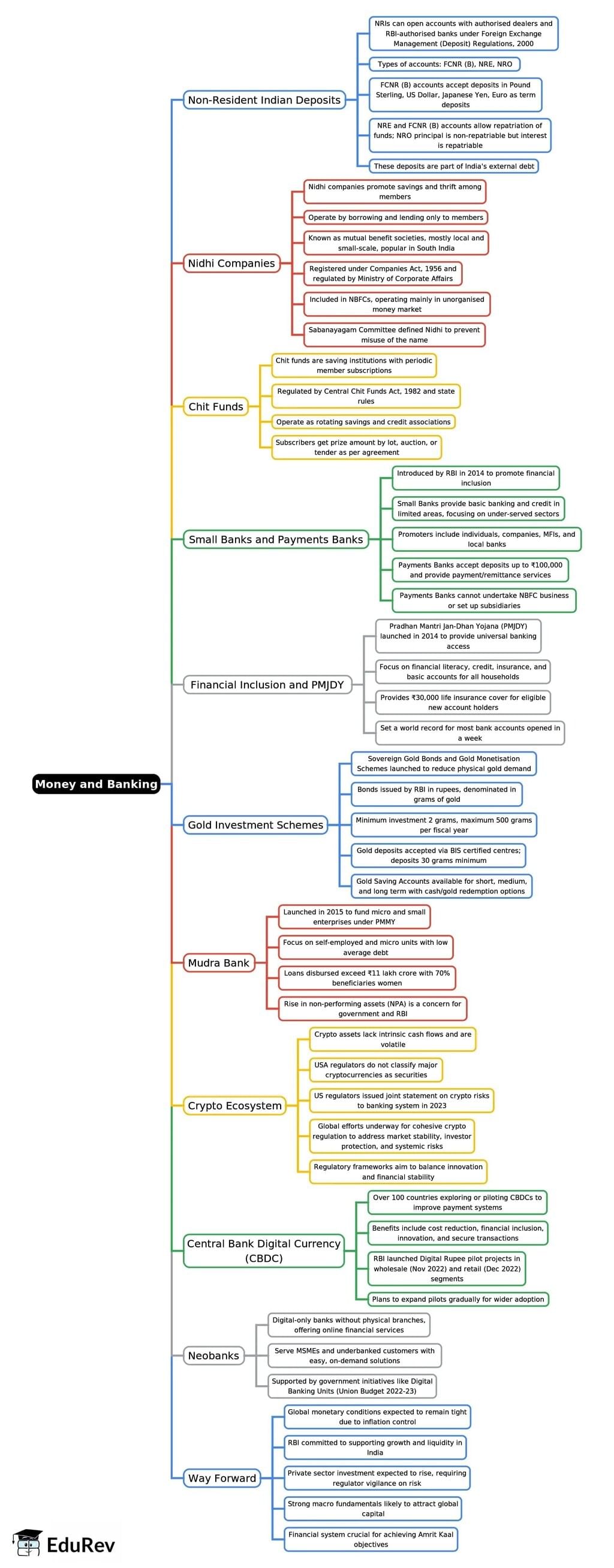UPSC Exam > UPSC Notes > Indian Economy for UPSC CSE > Mind Map: Money and Banking
Mind Map: Money and Banking | Indian Economy for UPSC CSE PDF Download
Money and Banking - 1

Money and Banking - 2

Money and Banking - 3

The document Mind Map: Money and Banking | Indian Economy for UPSC CSE is a part of the UPSC Course Indian Economy for UPSC CSE.
All you need of UPSC at this link: UPSC
|
108 videos|430 docs|128 tests
|
FAQs on Mind Map: Money and Banking - Indian Economy for UPSC CSE
| 1. What is the role of a central bank in the banking system? |  |
Ans. A central bank plays a crucial role in a country's economy by managing monetary policy, regulating the banking sector, and maintaining financial stability. It controls the money supply, sets interest rates, and acts as a lender of last resort to commercial banks. Additionally, the central bank oversees the implementation of banking regulations and ensures the smooth functioning of payment systems.
| 2. How do commercial banks create money? |  |
Ans. Commercial banks create money through a process known as fractional reserve banking. When a bank receives deposits, it is required to keep a fraction of those deposits as reserves while the rest can be loaned out. This lending process effectively increases the money supply in the economy. For instance, if a bank has a reserve requirement of 10%, it can lend out 90% of the deposited amount, thereby creating new money through the loans it issues.
| 3. What are the different types of banking systems? |  |
Ans. The banking systems can generally be categorized into three main types:
1. <b>Commercial Banks</b>: These banks provide services such as accepting deposits, offering loans, and facilitating transactions for individuals and businesses.
2. <b>Investment Banks</b>: They focus on raising capital for companies, facilitating mergers and acquisitions, and providing advisory services.
3. <b>Central Banks</b>: These institutions manage a country’s currency, money supply, and interest rates, and oversee the banking system.
| 4. What is the significance of monetary policy? |  |
Ans. Monetary policy is significant as it influences a country's economic activity, inflation, and employment levels. By adjusting interest rates and altering the money supply, central banks aim to achieve macroeconomic objectives such as stable prices and sustainable economic growth. Expansionary monetary policy can stimulate economic activity, while contractionary policy can help control inflation.
| 5. How do interest rates affect the economy? |  |
Ans. Interest rates have a profound impact on the economy by influencing borrowing costs and consumer spending. When interest rates are low, borrowing becomes cheaper, encouraging consumers and businesses to take loans for spending and investment, which can stimulate economic growth. Conversely, high interest rates can dampen borrowing and spending, potentially slowing down economic activity and controlling inflation.
Related Searches





















